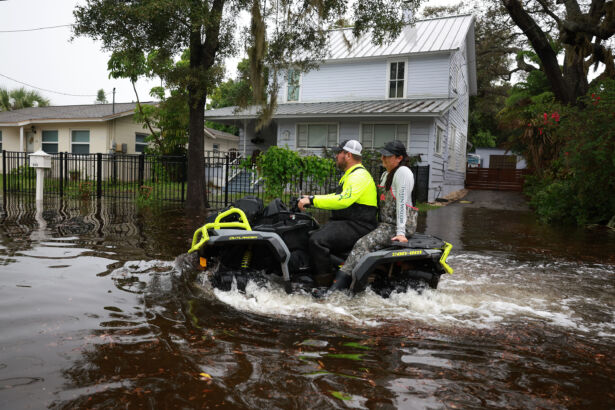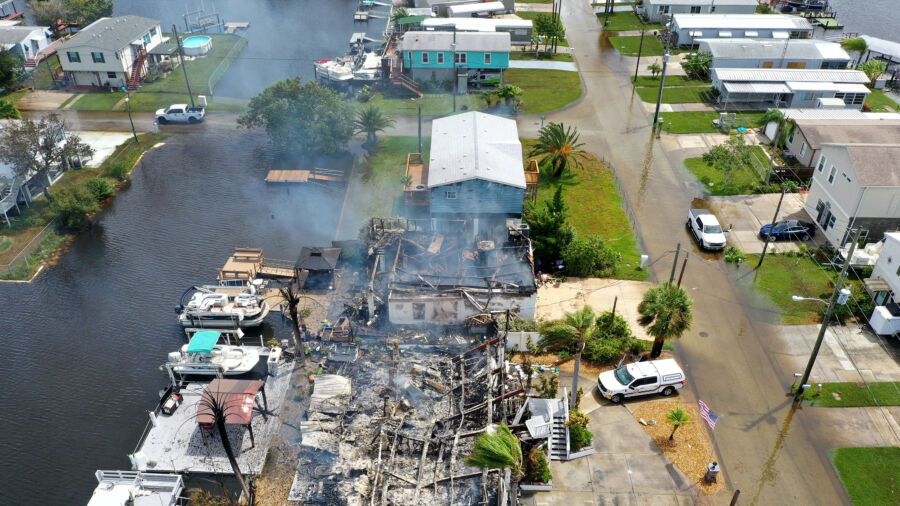Hurricane Idalia, which made landfall along Florida’s Big Bend region on Aug. 30, could top records in its intensification rate, hurricane experts have warned.
The hurricane eventually touched down as a Category 3 storm near Keaton Beach, along the Apalachee Bay, at around 7:45 a.m. ET, after experts had warned overnight it could intensify into an “extremely dangerous” Category 4 storm.
Still, the downgraded storm brought with it maximum sustained winds of around 125 mph, while water levels along the coast are rapidly rising, according to the U.S. National Hurricane Center (NHC).
Later on Wednesday, officials said winds had slowed down slightly to 105 mph, still a Category 2 hurricane.
Hurricanes, which are not an uncommon occurrence in Florida, typically form over warm ocean waters; building up energy as they suck up hot air from those waters while forming an area of low pressure underneath.
Hurricane Professor Kerry Emanuel, who teaches at the Massachusetts Institute of Technology (MIT), said that Idalia “stands a chance of setting a record for intensification rate because it’s over water that’s so warm.”
“Right now I’m pretty sure Idalia is rapidly intensifying,” Mr. Emanuel said.
At the time Emanuel said that, Idalia was clocking 80 mph winds. A couple hours later it was up to 90 mph, and by 10 p.m. Idalia was a Category 2 hurricane with 110 mph winds, having gained 40 mph in wind speed in 21 hours.
Scientists believe the warmer water temperatures, which in Florida Bay have been as high as 113 degrees Fahrenheit in recent months—are the result of the warming trend in the Pacific Ocean known as El Niño along with other weather events.

‘Rocket Fuel for the Storm’
Colorado State University hurricane researcher Phil Klotzbach also believes the hotter water temperatures are fueling up the storm, which will likely see it intensify.
“It’s 88, 89 degrees (31, 32 degrees Celsius) over where the storm’s going to be tracking, so that’s effectively rocket fuel for the storm,” Mr. Klotzbach said.
“It’s basically all systems go for the storm to intensify,” he added.
Elsewhere, University at Albany atmospheric sciences professor Kristen Corbosiero cited warmer waters as one of the reasons for Idalia’s intensification, noting that the storm has been parked at times over the Loop Current—a warm ocean current that flows northward between Cuba and the Yucatán Peninsula—and circular currents of water from that current known as “eddies.”
This would likely fuel its intensity even more, she explained.
“It’s not that those warm temperatures cause the storm to form,” Allison A. Wing, an associate professor of earth, ocean, and atmospheric science at Florida State University, told The New York Times. “It’s more that, if a storm is able to form, it can take advantage of those incredibly warm temperatures and become a strong storm.”
Within the past 24 hours, Hurricane Idalia has intensified rapidly, data from NHC shows, initially clocking in winds of 75 mph before shooting up to winds of nearly 130 mph.
Officials have warned the storm could bring “destructive life-threatening winds” along Florida’s Big Bend region with those strong winds expected to also hit portions of northern Florida and the adjacent states of Georgia and South Carolina.

2 Dead in Weather-Related Accidents
Widespread flooding this morning has already left homes and buildings in Florida submerged and rendered some roads unusable, with flood water inundating runways at Tampa International Airport, which has canceled all flights.
Currently, more than 270,000 people are without power.
Meanwhile, Florida officials have confirmed at least two people died as a result of Idalia— a 40-year-old man who died this morning in Pasco County, part of Florida’s Big Bend region, in a weather-related accident early this morning, and a 59-year-old man from Gainesville, Florida, was also killed after veering into a ditch and hitting a tree while driving.
Prior to Hurricane Idalia touching down, Florida Gov. Ron DeSantis, who is seeking the Republican nomination in the 2024 presidential election, urged residents to shelter in place.
The governor also declared a state of emergency and placed 49 of the state’s 67 counties under mandatory evacuation orders.
Speaking at a press conference Wednesday, Mr. DeSantis again warned residents not to venture outside and instead hunker down.
“Do not go outside in the midst of this storm,” the governor said. “If it’s calm where you are, it may be because you are in the eye of the storm and those conditions will change very, very quickly.
“So wherever you are, hunker down and don’t take anything for granted here, this is a very, very powerful storm,” Mr. DeSantis added.
Some analysts noted that Hurricane Idalia is the most powerful storm to make landfall along the Big Bend region, which historically doesn’t see a lot of hurricane activity, in 127 years. A hurricane in 1896 hit the region with 125 mph winds.
The Associated Press contributed to this report.
From The Epoch Times


